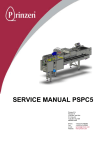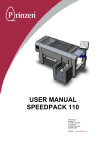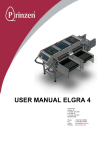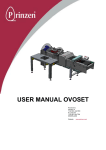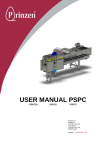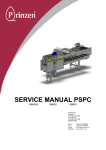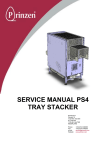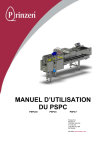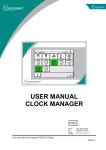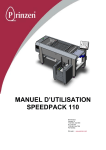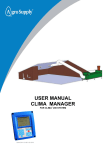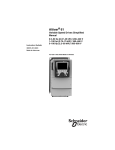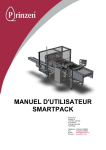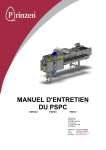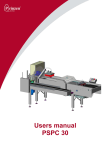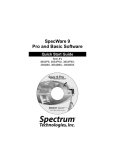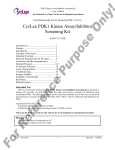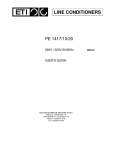Download user manual elgra 3
Transcript
USER MANUAL ELGRA 3 Prinzen B.V. Weverij 18 7122 MS AALTEN P.O. Box 85 7120 AB AALTEN NEDERLAND Phone: Fax: e mail: Website: +31(0) 543 490060 +31(0) 543 476205 [email protected] www.prinzen.com TABLE OF CONTENTS TABLE OF CONTENTS CHAPTER UM-ELGRA3-03-E/04-2011 BOOK INTRODUCTION I 1 SAFETY I 2 MACHINE DESCRIPTION I 3 OPERATION I 4 CLEANING I 5 PREVENTIVE MAINTENANCE I 6 ADJUSTMENTS I 7 SPARE PARTS I USER MANUAL ELGRA 3 Page 3 of 105 TABLE OF CONTENTS INDEX INTRODUCTION ................................................................................................................................................9 LIABILITY ............................................................................................................................................. 11 GENERAL............................................................................................................................................. 11 COPYRIGHT ......................................................................................................................................... 11 GENERAL............................................................................................................................................. 12 SAFETY REGULATIONS.......................................................................................................................... 12 LEGAL REGULATIONS............................................................................................................................ 12 HOW TO USE THIS MANUAL? ................................................................................................................. 13 WHO SHOULD USE THIS MANUAL? ......................................................................................................... 13 MANUAL INFORMATION ......................................................................................................................... 13 SERIAL NUMBER ................................................................................................................................... 13 SYMBOLS ............................................................................................................................................ 14 ADDRESS PRINZEN ............................................................................................................................... 14 EC-DECLARATION OF CONFORMITY FOR MACHINERY .............................................................................. 15 1. SAFETY..................................................................................................................................................17 GENERAL............................................................................................................................................. 18 SAFETY REGULATIONS.......................................................................................................................... 19 SAFETY PROVISIONS ............................................................................................................................ 21 DEFINITION OF SAFETY DEVICES............................................................................................................ 21 EMERGENCY BUTTON ........................................................................................................................... 22 SAFETY INSPECTION PROCEDURE ......................................................................................................... 22 WARNING LABELS ................................................................................................................................. 23 2. MACHINE DESCRIPTION .....................................................................................................................25 SAFETY REGULATIONS.......................................................................................................................... 26 MACHINE DESCRIPTION ........................................................................................................................ 27 ELGRA 3 ................................................................................................................................................................................................ 27 TECHNICAL SPECIFICATIONS ................................................................................................................................................................. 29 3. OPERATION ..........................................................................................................................................31 SAFETY REGULATIONS.......................................................................................................................... 32 EXPLANATION OF THE OPERATION ......................................................................................................... 33 OPERATING PANEL ................................................................................................................................................................................ 33 START-UP SCREEN................................................................................................................................................................................. 35 PRODUCTION SCREEN ........................................................................................................................................................................... 35 KEYPAD ................................................................................................................................................................................................ 36 ALARMS SCREEN ................................................................................................................................................................................... 37 BATCH PERFORMANCE DATA ................................................................................................................................................................ 38 MANUAL INPUT SCREEN ........................................................................................................................................................................ 39 RESET BATCH DATA SCREEN ................................................................................................................................................................. 40 TOTAL PERFORMANCE DATA................................................................................................................................................................. 41 UNIFORMITY ......................................................................................................................................................................................... 43 PRINT TICKET ........................................................................................................................................................................................ 44 WEIGHT CLASS SCREEN ......................................................................................................................................................................... 45 MANUAL MENU ..................................................................................................................................................................................... 46 PASSWORD SCREEN ............................................................................................................................................................................... 47 ELGRA .................................................................................................................................................................................................. 48 ELGRA MANUAL EJECT SOLENOIDS ....................................................................................................................................................... 48 ELGRA AUTO EJECT SOLENOIDS ............................................................................................................................................................ 48 SERVICE MENU...................................................................................................................................................................................... 49 MACHINE SETTINGS .............................................................................................................................................................................. 50 ELGRA CALIBRATION ............................................................................................................................................................................ 51 ELGRA LOAD-CELLS .............................................................................................................................................................................. 51 WEIGH TEST .......................................................................................................................................................................................... 52 CONFIGURATION SCREEN 1 ................................................................................................................................................................... 53 CONFIGURATION SCREEN 2 ................................................................................................................................................................... 54 ELGRA SETTINGS 1 ................................................................................................................................................................................ 55 ELGRA SETTINGS 2 ................................................................................................................................................................................ 56 UM-ELGRA3-03-E/04-2011 USER MANUAL ELGRA 3 Page 5 of 105 TABLE OF CONTENTS SAVE MACHINE SETTINGS ..................................................................................................................................................................... 57 USB STICK ............................................................................................................................................................................................. 57 SAVE BATCH DATA ............................................................................................................................................................................... 58 LANGUAGE ........................................................................................................................................................................................... 58 DATA.CSV FILE ..................................................................................................................................................................................... 59 PANEL SETTINGS ................................................................................................................................................................................... 60 PRODUCTION TIME SCREEN ................................................................................................................................................................... 60 DATE&TIME SCREEN ............................................................................................................................................................................. 61 CPU SCREEN .......................................................................................................................................................................................... 61 CONTRAST SCREEN ............................................................................................................................................................................... 62 NETWORK SCREEN ................................................................................................................................................................................ 62 I/O SCREEN............................................................................................................................................................................................ 63 SOFTWARE DEBUG SCREEN ................................................................................................................................................................... 63 GRAPHICS MENU ................................................................................................................................................................................... 64 GRAPHIC CONTINUOUSLY ..................................................................................................................................................................... 64 GRAPHIC EGG SAMPLE .......................................................................................................................................................................... 65 GRAPHIC ZERO SAMPLE......................................................................................................................................................................... 65 STARTING THE SYSTEM ......................................................................................................................................................................... 66 STOPPING THE SYSTEM ......................................................................................................................................................................... 67 4. CLEANING .............................................................................................................................................69 GENERAL............................................................................................................................................. 70 SAFETY REGULATIONS.......................................................................................................................... 70 CLEANING UTENSILS AND DETERGENTS ................................................................................................. 70 RECOMMENDED CLEANING AGENT ......................................................................................................... 71 GENERAL CLEANING PROCEDURE .......................................................................................................... 71 CLEANING INTERVAL ............................................................................................................................. 71 AFTER CLEANING ................................................................................................................................. 71 BEFORE CLEANING ............................................................................................................................... 72 CLEANING INSTRUCTIONS ..................................................................................................................... 73 CLEANING CONVEYOR .......................................................................................................................................................................... 73 CLEANING ROLLER TRACK .................................................................................................................................................................... 73 CLEANING WASTE BINS ......................................................................................................................................................................... 73 CLEANING PACKING TABLE ................................................................................................................................................................... 73 CLEANING ELEVATING UNIT ................................................................................................................................................................. 74 CLEANING EGG LANES .......................................................................................................................................................................... 74 CLEANING WEIGHING UNIT ................................................................................................................................................................... 75 5. PREVENTIVE MAINTENANCE .............................................................................................................77 GENERAL............................................................................................................................................. 78 SAFETY REGULATIONS.......................................................................................................................... 78 MAINTENANCE UTENSILS ...................................................................................................................... 78 GENERAL MAINTENANCE PROCEDURE ................................................................................................... 79 AFTER MAINTENANCE ........................................................................................................................... 79 MAINTENANCE COMPONENTS ................................................................................................................ 80 REMOVING FILTER ELECTRICAL CABINET ............................................................................................................................................. 80 ROLLER TRACK ACCESS ........................................................................................................................................................................ 80 PLC BATTERY REPLACEMENT ................................................................................................................................................................ 81 PREVENTIVE MAINTENANCE INSTRUCTIONS ............................................................................................ 82 DAILY PREVENTIVE MAINTENANCE ...................................................................................................................................................... 82 WEEKLY PREVENTIVE MAINTENANCE ................................................................................................................................................... 83 MONTHLY PREVENTIVE MAINTENANCE ................................................................................................................................................ 84 ½ YEARLY PREVENTIVE MAINTENANCE ................................................................................................................................................ 85 6. ADJUSTMENTS.....................................................................................................................................87 GENERAL............................................................................................................................................. 88 SAFETY REGULATIONS.......................................................................................................................... 88 AFTER ADJUSTMENTS ........................................................................................................................... 88 COMPONENT ADJUSTMENTS ................................................................................................................. 89 INDUCTIVE PROXIMITY SWITCHES ........................................................................................................................................................ 89 OPERATION ADJUSTMENTS ................................................................................................................... 90 GATE BLOCKERS ................................................................................................................................................................................... 90 START / STOP DELAY TIME .................................................................................................................................................................... 90 ADJUSTMENTS ..................................................................................................................................... 91 BELT TENSION ....................................................................................................................................................................................... 91 DRIVE CHAIN TENSION .......................................................................................................................................................................... 91 ELEVATING UNIT CHAIN TENSION ......................................................................................................................................................... 92 SYNCHRONIZING ROLLER TRACK TO ELEVATING UNIT .......................................................................................................................... 93 Page 6 of 105 USER MANUAL ELGRA 3 UM-ELGRA3-03-E/04-2011 TABLE OF CONTENTS SYNCHRONIZING ELEVATING UNIT TO EJECTING SYSTEM ..................................................................................................................... 95 ADJUSTING EGG LIFTERS ....................................................................................................................................................................... 97 ZERO WEIGHING SENSOR ....................................................................................................................................................................... 98 EGG WEIGHING SENSOR ...................................................................................................................................................................... 100 7. SPARE PARTS ....................................................................................................................................103 LIST WITH RECOMMENDED SPARE PARTS ............................................................................................. 105 UM-ELGRA3-03-E/04-2011 USER MANUAL ELGRA 3 Page 7 of 105 INTRODUCTION INTRODUCTION UM-ELGRA3-03-E/04-2011 USER MANUAL ELGRA 3 Page 9 of 105 INTRODUCTION CAUTION: This manual must be read by or to each person, before that person operates, cleans, repairs, supervises the operation of, or uses this machine in any way. CAUCION: Este manual debe ser leido por a cada persona antes de comenzar a operar, limpiar, reparar, supervisar la operación de, o utilizar esta maquina de cualquier manera. ATTENTION: Ce manuel doit être lu par, ou a, toute personne avant qu’elle ne mette en route, nettoie, répare, supervise le fonctionnement ou utilise cette machine, de quelque manière que ce soit. VORSICHT: Jeder, der diese Maschine bedienen, reinigen, reparieren, überwachen oder auf irgendeine Weise benutzen soll, muß vorher diese Hinweise lesen oder vorgelesen bekommen. ATTENTIE: Een ieder, die deze machine bedient, reinigt, repareert, controleert of op enige andere wijze gebruiken zal, dient vooraf deze bedieningsvoorschriften te lezen. CAUTELA: Il presente manuale deve essere letto da o ad ogni membro del personale prima che tale persona operi, pulisca, ripari, diriga il funzionamento o utilizzi la macchina in qualsiasi modo. Page 10 of 105 USER MANUAL ELGRA 3 UM-ELGRA3-03-E/04-2011 INTRODUCTION LIABILITY Prinzen BV cannot be held responsible for any costs, damage or personal injury if its system is not used in accordance with the instructions as described in this manual. The information provided in this manual is valid for the standard design of the system. Parts of your system may differ from this standard design. Since Prinzen BV is constantly improving its systems it may be possible that there are small differences between your system and this manual. Though this manual has been put together with the utmost care, Prinzen BV cannot accept any responsibility for costs, damage or personal injury arising from any fault and/or incompleteness in the content of this document. GENERAL This manual contains important information concerning safety, operation, adjustment, maintenance, cleaning and repair of the Prinzen BV system. For uncomplicated functioning of the system, read this manual carefully and work according to the directions in this manual. Beside the design and the used materials also the operation and maintenance have great impact on the functioning, the life span and the operational costs of our system. You, as the owner of the system, are responsible for the execution of maintenance according to the directions and the intervals in this manual. This manual will help you to gain knowledge to use the system as it should be used: Correct operated and excellent maintained. A Prinzen BV system meets the demands, mentioned in the European machine guideline (CE). COPYRIGHT Prinzen BV © This document contains confidential information and information protected by copyright of Prinzen BV. Reproduction or transmission of any part of this document to third parties, or the use thereof is only permitted after express written permission of Prinzen BV. All rights rest with Prinzen BV, Aalten, The Netherlands. Written by Visser Machine Services. UM-ELGRA3-03-E/04-2011 USER MANUAL ELGRA 3 Page 11 of 105 INTRODUCTION GENERAL This manual contains important information concerning safety, operation, cleaning, maintenance and breakdown remedies. At all time this manual must be accessible for all personnel working with the system. Keep it in a permanent place, close to the system. When the manual is lost or damaged, order a new copy as soon as possible. The user of the system should read and understand the total user manual before operating, cleaning, maintaining and repairing the system. Never change the sequence of procedures as described in this manual. SAFETY REGULATIONS Before starting operation, cleaning, maintaining the system or before remedying breakdowns first read this chapter and chapter Safety. LEGAL REGULATIONS - - - All safety directions stated in this manual must be observed. Along with the safety regulations in this chapter the instructions of the qualified trade organization of your country must be observed to avoid accidents. Before starting to repair or maintain the machine always consult your safety manager to discuss if a work permit is required for this job. All safety devices in the machine and the safety indications mentioned in this manual are conditions to control the machine safely. The owner and his qualified personnel are in the end the ones responsible for the safe use of the machine. The owner is responsible for the ability of the qualified personnel to perform its duties according to the safety measures. Technical changes, which influence the safety working of the machine, may only be executed by the service department of Prinzen. Do not change controls, and/or PLC programs, without written permission from Prinzen because this may affect the safety of the machine. Only use genuine Prinzen parts or CE-certified parts for replacement. Prinzen cannot be held responsible for any consequential damages to the system or other installations that were caused by technical changes, unprofessional maintenance and repairs on our system, which were executed by the customer. Warranty becomes invalid when consequential damages to the system, caused by technical changes, unprofessional maintenance and repairs, were executed by the customer. DANGER! Failure to obey legal regulations may result in permanent personal injury or death. ATTENTION! Failure to obey legal regulations may result in damage to the system. Page 12 of 105 USER MANUAL ELGRA 3 UM-ELGRA3-03-E/04-2011 INTRODUCTION HOW TO USE THIS MANUAL? The manual is constructed to provide a maximum amount of information with a minimum amount of searching. The key to easy reference is the Table of contents. WHO SHOULD USE THIS MANUAL? Owner: The owner (contractor, concern) is the person that owns or hires the machine and puts this machine into production. The owner must take care that the users of the system will read the manual. Operator: The operator is the person who operates the system as ordered by the owner. The operator must read the chapters Introduction, Safety, Machine description, Operation, Cleaning. Professional: A professional is someone who can assess the duties appointed to him on account of his education, knowledge and experience and who can assess the dangers attached, thereby avoiding these dangers. Maintenance engineer: The maintenance engineer is the professional who is deemed qualified by the owner to perform certain duties. The qualification only applies to those assigned duties. The maintenance engineer must read the total manual. MANUAL INFORMATION Machine type: Manual revision: Elgra 3 03 (April 2011) SERIAL NUMBER Each machine has a unique serial number printed on the machine tag, which can be found in the electrical cabinet. Note down this serial number to have it available when contacting the Prinzen service department. Elgra 3 3~N 50Hz 400/230V 3 x 25A EL1268 08-2010 UM-ELGRA3-03-E/04-2011 USER MANUAL ELGRA 3 Page 13 of 105 INTRODUCTION SYMBOLS Symbols are used in the manual when special attention/caution is required while working on the system. The special symbols and their meaning are depicted in the below table. Symbol: Meaning: DANGER! This symbol is used when instructions should be followed to the letter. If not they may result in permanent personal injury or death. CAUTION! This symbol is used when instructions should be followed to the letter. If not they may result in permanent personal injury. ATTENTION! This symbol is used when instructions should be followed to the letter. If not they may cause damage to the system. NOTE! This symbol advises to use edible products and to work in a hygienically way. Disregarding this advice may cause illness. TIP! This symbol is used as a helpful hint to simplify the execution of certain tasks. ADDRESS PRINZEN Prinzen BV Weverij 18, 7122 MS AALTEN P.O. Box 85, 7120 AB AALTEN The Netherlands Telephone: Fax: E-mail: Website: Page 14 of 105 +31 (0)543 490060 +31 (0)543 476205 [email protected] www.prinzen.com USER MANUAL ELGRA 3 UM-ELGRA3-03-E/04-2011 EC-DECLARATION EC-DECLARATION OF CONFORMITY FOR MACHINERY Concerning the machinery directives: Prinzen B.V. Weverij 18 7122 MS AALTEN The Netherlands 1 Herewith declares that we are the manufacturer of the egg-packing machine on which this declaration applies: Brand: Type: Serial number: Prinzen Elgra 3 2 The machine is developed in compliance with the demands of the machinery directive 2006/42/EC (most recent). 3 The machine meets the provisions of the following directives: The low voltage equipment directive 2006/95/EC (most recent). The EMC-directive 2004/108/EC (most recent). 4 The machine is developed and constructed according the following standard: NEN-EN-IEC 60204-1: 2006 Electrical equipment of industrial machines. Signed in: Date: Aalten 24-08-2010 Signed by: G.J. van Eerden UM-ELGRA3-03-E/04-2011 USER MANUAL ELGRA 3 Page 15 of 105 SAFETY 1. SAFETY UM-ELGRA3-03-E/04-2011 USER MANUAL ELGRA 3 Page 17 of 105 SAFETY GENERAL Only persons meeting the following requirements are authorized to work with the system. These persons should be: - Skilled and specifically trained for their duties. - Familiar with the contents of this manual. - Familiar with the locations of the emergency buttons and other safety devices. - 18 years old or above. - Familiar with the national and regional regulations regarding safety. These persons should have reached the minimum legal age required to perform this work. These persons are NOT under influence of any drug, medicine or alcoholic drink. DANGER! Keep children and incompetent persons away from the system! The system is only to be used for the purpose it was designed for. See the chapter Machine description for details. Page 18 of 105 USER MANUAL ELGRA 3 UM-ELGRA3-03-E/04-2011 SAFETY SAFETY REGULATIONS Do not use the system when safety devices have been removed. This system may contain sharp edged parts, moving parts and rotating parts. When protective covers are removed, sharp edges and pinch points may be exposed. Use extreme caution and avoid touching or striking these areas with your hands or body because they may cause injuries. Do not enter parts of your body or objects into openings in the system. This may lead to serious physical injury or damage to the system. It is dangerous to be in, on or under the system while it is operational. Loosely hanging clothing, wide sleeved clothing, ties, chains or rings are prohibited. Long hair should be worn tied back. Make sure that there is sufficient light around the machine. Do not touch or come near moving or rotating parts. Physical contact with these parts is dangerous. Do not stand or walk on any of the system parts. Do not work alone on the system. At least one other person should be present Before starting to clean, maintain or inspect the machine or before remedying breakdowns follow the steps mentioned below: - Switch off the machine and secure it against accidental switching on. - Post “Do not switch on” warning sign on the main switch: - Operate the nearest emergency button. - Make sure that no components are moving. Before switching on the machine, you must check the following: - All safety devices are in place and are functioning. - No other persons are in, underneath or above the system. - No tools or objects are in the system. - No other persons are at risk. Do not use water to clean electricity cabinets and other electronic components. For save and easy operation keep the area and floor around the machine clean, free of oil, grease or obstacles. Remove superfluous fat and greasing oil after greasing duties. When an extension cable is used for power supply, make sure that the cable diameter in relation to the length of the cable is correct. Make sure the cable is completely unrolled Manual activation of safety switches is forbidden. When the safety devices are put out of operation, the machine must first be switched off and secured against accidental switching on. Work inside the electrical cabinet may only be undertaken by skilled personnel like Prinzen service engineers or its dealer’s service engineers. Always switch off the main switch before opening electrical cabinets. After switching off the main switch, parts inside the electrical cabinet remain live for approximately 1 minute. The frequency inverters may hold a high voltage charge during this time. Do not touch parts inside the electrical cabinet as long as displays of frequency inverters are on. UM-ELGRA3-03-E/04-2011 USER MANUAL ELGRA 3 Page 19 of 105 SAFETY Several parts inside the electrical cabinet maintain voltage even when the main switch is turned off (main switch, main power supply, terminals for egg collecting belts, etcetera). DANGER! Failure to obey safety regulations may result in permanent personal injury or death. ATTENTION! Failure to obey safety regulations may result in damage to the system. Page 20 of 105 USER MANUAL ELGRA 3 UM-ELGRA3-03-E/04-2011 SAFETY SAFETY PROVISIONS 1 Before operating the machine the safety devices must be checked for correct functioning. Also the protective covers must be mounted before starting to use the system. Repair or replace safety devices before using the system if they do not work properly. Never rely solely on safety devices. Always switch off the system and lock up the power source (1) before working on the machine. DANGER! Protective covers safeguard dangerous machine areas. These covers are of utmost importance to operate the machine safely. Never operate the machine when protective covers are removed because serious injury or death may occur! 2 DEFINITION OF SAFETY DEVICES 3 Safety devices are: lockable doors (2), emergency buttons (3) and protective covers (4). 4 The emergency button prevents the machine from operating and should stop the machine immediately when it is pressed. Protective covers shield off dangerous moving parts. These covers cannot be removed without tools. Lockable doors are doors that can only be opened with a key. The key should only be in possession of a supervisor. DANGER! Lockable doors safeguard dangerous machine areas. These doors are of utmost importance to operate the machine safely. Never operate the machine when doors are open or not locked because serious injury or death may occur! UM-ELGRA3-03-E/04-2011 USER MANUAL ELGRA 3 Page 21 of 105 SAFETY EMERGENCY BUTTON To stop the machine in case of an emergency, the system has one or more emergency buttons. Only use the emergency button in case of an emergency. When the emergency button is pressed, the system stops immediately. The button stays mechanically locked so the machine cannot start until it is considered safe to do so. Release the emergency button by turning it clockwise. Do not release the emergency button when it is not certain why and by whom it was pressed. Personnel working with the system must know the positions of the emergency buttons. SAFETY INSPECTION PROCEDURE Before starting the machine all protective covers must be in place, all covers must be closed and the emergency buttons must be operating. Trained personnel must check safety devices to assure proper operation. 1. Check that all protective covers are in place and all covers are closed. 2. Start and stop the system. 3. Push the emergency button. 4. Push the start button, the machine should not start. 5. Release the emergency button. 6. Make sure that the machine does not start when the emergency button is pressed. If the machine operates when the emergency button is pressed, this machine is not safe to operate. Immediately call a qualified technician to repair the defective emergency button. Page 22 of 105 USER MANUAL ELGRA 3 UM-ELGRA3-03-E/04-2011 SAFETY WARNING LABELS The Prinzen system makes dangerous movements. The system also contains dangerous parts when they contact the body. The following labels are posted as a warning. Understand and remember the meaning of the warning labels. DANGER! Keep the warning labels clean. When labels become unclear, replace them. The flashlight label is used to warn for dangerous voltage inside a cabinet. Contacting parts inside this cabinet may result in permanent personal injury or death. This sign is used to warn for dangerous movements. Keep a safe distance to those parts. Disregarding this warning may result in permanent personal injury. This sign is used to warn for the danger of limbs being pulled in. Keep a safe distance to those parts. Disregarding this warning may result in permanent personal injury. This sign is used to warn for crushing danger. Keep a safe distance to those parts. Disregarding this warning may result in permanent personal injury. UM-ELGRA3-03-E/04-2011 USER MANUAL ELGRA 3 Page 23 of 105 SAFETY This sign is used to warn for damaging the system during installation and start up of a new system. It is only used in systems with a roller track. To prevent roller shafts falling out of the roller track during transportation of the system, a tie wrap holds the transport chains of the roller shafts together. After installing the system remove the tie wrap. Disregarding this warning, not removing the tie wrap and starting the system, will result in damaging the system. ATTENTION! Not removing the tie wrap will damage the system! Page 24 of 105 USER MANUAL ELGRA 3 UM-ELGRA3-03-E/04-2011 MACHINE DESCRIPTION 2. MACHINE DESCRIPTION UM-ELGRA3-03-E/04-2011 USER MANUAL ELGRA 3 Page 25 of 105 MACHINE DESCRIPTION SAFETY REGULATIONS Before starting operation, cleaning, maintaining the system or before remedying breakdowns first read the chapters Introduction and Safety. Page 26 of 105 USER MANUAL ELGRA 3 UM-ELGRA3-03-E/04-2011 MACHINE DESCRIPTION Use: The Elgra 3 is used to electronically weigh eggs and separate these eggs into 3 userdefined sizes. MACHINE DESCRIPTION ELGRA 3 Construction: The Elgra 3 consists of: 1 Infeed conveyor 2 Infeed gate 3 Main drive 4 Roller track 5 Weighing unit 6 Elevating unit 7 Ejecting system 8 Packing table 9 Electrical cabinet 10 Operating panel 6 4 9 10 2 11 1 8 5 7 3 UM-ELGRA3-03-E/04-2011 Process: Eggs are entering the Elgra 3 on the infeed conveyor where the eggs may be graded. On this belt oversized-, misshapen-, cracked- or dirty eggs should be manually removed. Egg pressure control sensors (11) on the sides of the infeed conveyor prevent accumulation of eggs on the infeed conveyor. Via the infeed gate the eggs roll in between 2 roller shafts of the roller track. The geared roller shafts running over racks turn the roller shafts in 2 directions. Because of the shape of the rollers and this rotating movement, the eggs are positioned flat in between the rollers at the end of the roller track. Here the eggs are transferred via star-wheels onto an egg lane and are guided towards load-cells by elevator shafts. On the load-cells the eggs are weighted. After weighing, the elevator shafts move the eggs further towards the ejecting system. During this transport the eggs are tracked for controlling their correct destination depending on their weight. When the ejectors remain down, the eggs are transported towards the downstream system. When an ejector moves upwards, the elevator shaft lifts the egg up and transports it towards the packing table where the eggs need manual removal. The operator defines which egg sizes are transported to which outfeed direction by defining 3 weight classes (weight class small, hatch and big). Eggs which fall within the weight class hatch are transferred to the downstream system, small and big eggs are transferred to the packing table. Since the difference between the small and the big eggs is visible it is easy to manually separate these eggs while packaging. USER MANUAL ELGRA 3 Page 27 of 105 MACHINE DESCRIPTION It is possible to connect a packer (PSPC) or another conveyor to the Elgra 3 for further transport of the eggs. 12 13 Safety: The Elgra 3 is not completely secured with protective covers. Therefore be cautious with loosely hanging clothes and long hair, do not come too close to the Elgra 3 and do not touch it when it is running production. Pay special attention to: - The infeed conveyor. - The roller track. - The elevating unit. - The ejecting system. Never touch or come near these parts of the Elgra 3 when it is running production. The cover above the elevating system does not have a safety switch. The system remains running when it is opened. The ejecting system makes unexpected fast and powerful movements. Never touch or come near this part when the system is running production. See alongside picture for position of the emergency stop (12) and power switch (13). CAUTION! The cover above the elevating unit is NOT a safety cover. Opening this cover does NOT stop the system. CAUTION! Keep distant to the ejecting system! It makes unexpected fast and powerful movements! CAUTION! Do not enter objects or body parts into the system when it is running production. ATTENTION! Do not enter objects or body parts into the system when it is running production. ATTENTION! A force of more than 3 kilo’s damages the loadcells in the weighing unit. Never put any force or pressure on the load-cells! Page 28 of 105 USER MANUAL ELGRA 3 UM-ELGRA3-03-E/04-2011 MACHINE DESCRIPTION TECHNICAL SPECIFICATIONS The construction of your system may differ slightly from the descriptions in this manual. Because of this the data in the technical specifications may be incorrect and/or incomplete for your system. For complete and exact data, see the lay-out drawing, the electrical drawings and the machine tag of your system. Restrictions: Eggs longer than 76 mm or wider than 52 mm cannot run through the system and should be manually removed from the infeed conveyor. Also dirty eggs and eggs with cracks should be removed from the infeed conveyor. Specifications: Resolution Accuracy Maximum houses or batches Maximum amount of total eggs Maximum egg mass Maximum speed : : : : : : 0,1 grams. 0,3 grams absolute. 8 ± 524.000 36.680 kg (± 524.000 eggs of 70 grams) 15.000 eggs/hour TIP! When the maximum permitted data is reached, reset the performance data. Otherwise performance data on touchpanel and ticket are incorrect! Electrical data: Connection voltage : 400V 3 phase + N + PE 50Hz Connection : 5x2,5 mm² Pre fuse minimum : 20 Amp, slow blowing Pre fuse maximum : 25 Amp, slow blowing Maximum current : 3 Amp Power : 0,5 kW Maximum voltage deviation : -6% to +10%. Electrical protection : IP55 A ground-fault circuit interrupter (earth leak protection) is not a necessity, but if required or present it should have a minimum leakage current of at least 200 mA. Transport and Installation: Weight Dimensions: : : ± 200 kg 192 (l) x 60 (b) x 120 (h) cm. Environment: The climate around the machine must have a normal air moisture and a temperature in between 10ºC and 30ºC. During transport and storage the temperature of the system should remain in between 0°C and 45°C. The system is not suitable for outdoor use and should not be used in a surrounding containing items having a high flash point or an explosive nature. Environment consequences: Dismantling and disposal of the system must be carried out by a suitable disposal company, which has the required licenses and permits for the state or the country concerned. Dismantled materials should be sorted for disposal according to local rules and regulations that may apply. Separate all materials like oil and lubrication fluids and discharge them as chemical waste. UM-ELGRA3-03-E/04-2011 USER MANUAL ELGRA 3 Page 29 of 105 OPERATION 3. OPERATION UM-ELGRA3-03-E/04-2011 USER MANUAL ELGRA 3 Page 31 of 105 OPERATION SAFETY REGULATIONS Before starting operation, cleaning, maintaining the system or before remedying breakdowns first read the chapters Introduction and Safety. Page 32 of 105 USER MANUAL ELGRA 3 UM-ELGRA3-03-E/04-2011 OPERATION EXPLANATION OF THE OPERATION OPERATING PANEL In the operating panel the touchpanel with PLC is situated. The PLC controls the Elgra3. The touchpanel shows information about the status of the system. By pressing on certain parts of the touchpanel, depending on the chosen button or screen, the system is controllable, process settings can be changed or information becomes visible on the screen. Optionally it is possible to control downstream systems like a PSPC via this touchpanel besides controlling the Elgra 3. DANGER! Although a lot of safety measures are built into the control of the system, Prinzen cannot guarantee that no dangerous situations will occur. Before you start the system, make sure no persons are in danger. DANGER! By working on a higher operating level, you have more possibilities to control the system manually. Before starting to move parts of the system, you have to assure yourself no other persons are in danger. Make sure nobody is around the part you intend to move. ATTENTION! By working on a higher operating level, you have more possibilities to control the system manually. When you move parts manually, it may be possible that parts will collide, resulting in damage of the system. UM-ELGRA3-03-E/04-2011 USER MANUAL ELGRA 3 Page 33 of 105 OPERATION ATTENTION! It is not necessary to press real hard on the Touch Panel. We advise against doing this because it may damage the Touch Panel. It is forbidden to press on the Touch Panel with (sharp) objects because this may also damage the Touch Panel. Emergency stop: After pushing the red button, the Elgra 3 stops immediately. Rotate the red button to release the emergency stop. The emergency stop stops the complete system. Start the system with the start button on the operating panel. TIP! Only use the emergency button for real emergencies. Follow the normal stop procedure to stop the system. Start: By pressing the start button, the system starts to run. The light inside the button turns ON. When you start to move parts of the system manual (see the manual menu), the light inside the button starts flashing. The start button is also used to manually move the Elgra by holding the stop button and tipping this start button. Stop: By touching the stop button, you will stop the system. The system stops after finishing certain internal controlling cycles. Thus it may take some time before the system is completely stopped. This is the normal procedure to stop the system. The stop button is also used to manually move the Elgra by holding this stop button and tipping the start button. Reset: After a breakdown, first the breakdown needs to be solved. During a breakdown, the light inside the reset button turns ON. After solving the breakdown and pressing the reset button, the controller verifies if all breakdowns are solved. When this is the case, the light inside the reset button turns OFF. Now it is possible to start the system by pressing the start button again. Optional USB socket: In the optional USB socket it is possible to plug in a USB stick. After this it is possible to store or load machine settings or to store performance data of the flocks. Optional ticket printer: The optional ticket printer is used to print the performance data (performance of a batch or house, or the total performance data). The batch performance data (or house performance data) is printed after touching the print button on the batch performance data screen. The total performance data is printed after touching the print button on the total performance data screen. Page 34 of 105 USER MANUAL ELGRA 3 UM-ELGRA3-03-E/04-2011 OPERATION START-UP SCREEN After switching on the system with the main switch the start-up screen appears. After touching this (1) button the production screen appears. 1 3 2 4 5 6 7 8 9 10 PRODUCTION SCREEN In the production screen the operator is able to control the system. Alarm message line (2): On the top of the screen the alarm messages may appear when the system needs assistance. See alarm messages for possible alarms that may popup. Alarm screen (3): On all screens the alarm screen button is available. After touching this button you will enter the alarm screen. Buttons (4): With the buttons it is possible to switch parts of the Elgra 3 ON or OFF. Beside this the buttons indicate the status of these units: White: Unit is not running. Green: Unit is running. Red: Unit has a breakdown. Yellow: Unit is in the manual mode. Infeed: After touching the infeed button, the upstream conveyor supplying eggs to the Elgra 3 starts to run Grader: After touching the grader button the Elgra 3 starts to run. Weighing: After touching the weighing button, the weighing unit is activated. Manual submenu (5): After touching this button the manual menu appears in which it is possible to manually control parts of the system. This menu is not available for the operator. UM-ELGRA3-03-E/04-2011 USER MANUAL ELGRA 3 Page 35 of 105 OPERATION Service submenu (6): After touching this button the service menu appears. In this menu the operator is able to change a number of settings using submenus. Not all submenus are available for the operator. Batch performance data screens (7): After touching this button, the batch performance data screens appear where the performance data is displayed. Since this is a lot of data, it is divided over several screens. Weight class screen (8): After touching this button, the weight class screen appears in which it is possible to set the weight class of the eggs and the destination of the eggs (which weight class goes to the downstream system and which weight class goes to the packing table). UV light (9): This is a toggling button for switching the optional UV lights ON or OFF. Candling light (10): This is a toggling button for switching the optional candling lights ON or OFF. KEYPAD 11 After touching yellow windows, the keypad appears (11). Enter a correct value and confirm it with the V button (12). 12 Page 36 of 105 USER MANUAL ELGRA 3 UM-ELGRA3-03-E/04-2011 OPERATION ALARMS SCREEN 21 20 22 The Alarms current screen shows all present alarms from the system. By touching the up- or down arrows (20) it is possible to scroll through the alarm list. An active alarm is colored red. st By touching the R button (21) the 1 time, the alarm is reset. When the breakdown causing the alarm is not solved, the alarm immediately pops-up again. After touching the alarm history button (22) the alarm history screen appears. 23 Previous (23): After touching this arrow button the previous screen appears. Submenu Alarm history: The Alarm history screen shows the history of all alarms from the system. By touching the up- or down arrows (25) it is possible to scroll through the alarm list. 25 UM-ELGRA3-03-E/04-2011 USER MANUAL ELGRA 3 Page 37 of 105 OPERATION BATCH PERFORMANCE DATA 30 35 31 32 33 34 TIP! To prevent loss of performance date, only change the batch or house number after finishing the current batch or house. TIP! After touching the reset button all batch performance data is deleted! Since the batch performance data contains a lot of data it is divided over 2 screens. Batch number / house number (30): Here the number of the batch (hatchery) or house (farm) from which the eggs are currently running through the Elgra is displayed. Here it is also possible to select a different batch or house. Only change the batch or house number after the current batch or house is completely finished and the Elgra is stopped. Otherwise performance data of the different batches or houses gets mixed up. Print (31): After touching this print button, all performance data (since the last reset) of the selected batch (hatchery) or house (farm) is printed on the optional ticket printer: Manual input screen (32): After touching this button the manual input screen appears in which it is possible to enter the amount of eggs that were manually removed before they entered the Elgra 3. Reset (33): After touching this button the reset batch data screen appears in which it is possible to delete or to save and delete the performance data of the current batch. Batch performance data next screen (34): On the batch performance data screen the performance date of the current batch or house after the last reset is displayed. Since this data does not fit on 1 screen it is divided over 2 screens. Touch this button to enter the next screen with performance data. Batch performance data (35): Following batch or house performance data is available: Weighed eggs: The amount of eggs the Elgra has weighted is displayed here. Average weight: The average weight of all eggs is displayed here. Uniformity: The percentage of eggs which fall within a bandwidth of + and –10% towards the total amount of eggs is displayed here. See uniformity explanation further on in this chapter. Egg weight: The total weight of all eggs weighted is displayed here. Page 38 of 105 USER MANUAL ELGRA 3 UM-ELGRA3-03-E/04-2011 OPERATION 35 36 Amount of eggs small: The amount of small eggs the Elgra has weighted is displayed here. Amount of eggs hatch: The amount of hatch eggs the Elgra has weighted is displayed here. Amount of eggs big: The amount of big eggs the Elgra has weighted is displayed here. Hatching percentage: The amount of hatch eggs in relation to the total amount of eggs is displayed here. Laying percentage: This data is only available for a farmer. In a hatchery this data is not present. The amount of eggs in relation to the number of hens in a house is displayed here. Number of hens: This window is only available for a farmer. In a hatchery this window is not present. After touching the window a keypad pops-up in which it is possible to enter the amount of hens for a certain house. This information is used to calculate the laying percentage. Total performance data next screen (36): After touching this arrow button, a screen with the total performance data appears. MANUAL INPUT SCREEN In this screen it is possible to enter the amount of eggs with double yolks, dirty eggs and eggs with a crack, which have been manually removed before entering the Elgra. The entered data in this screen is added to the automatically counted eggs and is used for calculating the exact performance data. UM-ELGRA3-03-E/04-2011 USER MANUAL ELGRA 3 Page 39 of 105 OPERATION RESET BATCH DATA SCREEN After touching the reset button on the batch performance data screen one of the alongside screens appear. When a USB socket is present on your system it is possible to just reset the performance data of your flocks, but it is also possible to first save the data before resetting it. When no USB socket is present on your system it is only possible to reset the performance data of your flocks. 37 38 39 Reset performance data (37): After touching this button, the performance data of the current batches or houses is reset. Save and reset performance data (38): After touching this button, first the performance data of the current batches or houses is saved after which the data is reset. Cancel (39): After touching the cancel button the performance data is not reset and/or saved. 37 Page 40 of 105 TIP! After touching the reset button all batch performance data is deleted! 39 USER MANUAL ELGRA 3 UM-ELGRA3-03-E/04-2011 OPERATION TOTAL PERFORMANCE DATA Since the batch performance data contains a lot of data it is divided over 2 screens. 41 40 UM-ELGRA3-03-E/04-2011 Total performance data next screen (40): On the total performance data screen the total performance date of the Elgra after the last reset is displayed. Since this data does not fit on 1 screen it is divided over 2 screens. Touch this button to enter the next screen with total performance data. Total performance data (41): Following total performance data is available: Total amount of eggs small: The total amount of small eggs the Elgra has weighted is displayed here. Total amount of eggs hatch: The total amount of hatch eggs the Elgra has weighted is displayed here. Total amount of eggs big: The total amount of big eggs the Elgra has weighted is displayed here. Total amount of weighed eggs: The total amount of eggs the Elgra has weighted is displayed here. Total egg weight: The total weight of all eggs weighted is displayed here. Average weight: The average weight of all eggs is displayed here. USER MANUAL ELGRA 3 Page 41 of 105 OPERATION 41 42 43 TIP! After touching the reset button, the total performance data is deleted! Uniformity of all batches: The percentage of eggs which fall within a bandwidth of + and –10% towards the total amount of eggs is displayed here. See uniformity explanation further on in this chapter. Total amount eggs (including manual): The total amount of eggs the Elgra has weighted including the manual removed eggs (manually entered see manual input screen) is displayed here. Total hatching percentage: The total amount of hatch eggs in relation to the total amount of eggs is displayed here. Laying percentage: This data is only available for a farmer. In a hatchery this data is not present. The total amount of eggs in relation to the total number of hens in all houses is displayed here. Number of hens: This data is only available for a farmer. In a hatchery this data is not present. The total amount of hens in all houses is displayed here. Print (42): After touching this print button in the total performance data screen, the total performance data (since the last reset) is printed on the optional ticket printer: Reset (43): After touching this button the alongside screen appears in which it is possible to reset the total performance data. Reset performance data (44): After touching this button, the total performance data is reset. Cancel (45): After touching the cancel button the total performance data is not reset. 44 Page 42 of 105 45 USER MANUAL ELGRA 3 UM-ELGRA3-03-E/04-2011 OPERATION UNIFORMITY The alongside graphic is an example. It shows the amount of eggs per weight class, which visualizes the uniformity of eggs collected from the particular batch or house (since the last reset). In this example 2865 eggs are collected with an average weight of 60,85 grams. 288 eggs fall within 60 and 61 grams, 269 eggs fall within 61and 62 grams, etcetera. The controller determines 47 weight areas. Around each area it creates a weight band of + and – 10%. For example 10% of 45 grams is 4,50 grams. The weight band around the 45 grams area is from (45-4,5=) 40,50 grams to (45+4,5=) 49,50 grams. Each egg with a weight in between 40,50 grams and 49,50 grams is placed in the 45 grams weight area. In the alongside table all 2865 collected eggs are placed in the several weight areas. In this example the weight area with the highest score is the 60 grams area (weight of the eggs in between 54 and 66 grams) with 2544 eggs. The uniformity definition: The percentage of eggs which fall within a bandwidth of + and –10% towards the total amount of eggs. In the example 2544 eggs of the total of 2865 collected eggs fall within this bandwidth of + and – 10%. The uniformity = (2544/2865)x100% = 88,7% UM-ELGRA3-03-E/04-2011 USER MANUAL ELGRA 3 Page 43 of 105 OPERATION PRINT TICKET When the optional ticket printer is present it is possible to print the performance data. Depending on the screen where the print button is touched, the performance data of the batch or house (batch performance data screen) or the total performance data is printed (total performance data screen). On the ticket the following information since the last reset may be printed: Date: Date during printing. Batch or House or Totals: When Batch or House is printed, the batch number or house number is printed. Weighed eggs: Total amount of eggs which ran through the Elgra. Avg. egg weight: Average weight off all the eggs, which passed the load-cells. Low limit and High limit: The weight limits as entered in the weight class screen. When 0 is displayed in the totals print, the limits are changed for different batches or houses. Small: Eggs falling within the small weight class. Hatch: Eggs falling within the hatch weight class. Big: Eggs falling within the big weight class. Egg mass: Total weight of all eggs, which passed the load-cells Uniformity: The calculated uniformity, see uniformity for explanation. Hatch.perc: The amount of hatch eggs in relation to the total amount of eggs. Laying perc: This data is only printed for a farmer. The amount of eggs in relation to the number of hens in a house. Nr_hens: This data is only printed for a farmer. The amount of hens in a house. Doubleyolkers: The amount of manual removed eggs with double yolks. Cracks: The amount of manual removed cracked eggs. Dirts: The amount of manual removed dirty eggs. Page 44 of 105 USER MANUAL ELGRA 3 UM-ELGRA3-03-E/04-2011 OPERATION WEIGHT CLASS SCREEN Here it is possible to set the weight class of the eggs and the destination of the eggs (downstream system or packing table). Class1 (small): The low limit of this class is set at 20 grams and cannot be changed. Changing the high limit of this class also changes the low limit of class 2. Class 2 (hatch): Changing the low limit of this class also changes the high limit of class 1. Changing the high limit of this class also changes the low limit of class 3. Class 3 (big): Changing the low limit of this class also changes the high limit of class 2. The high limit of this class is set at 120 grams and cannot be changed. Example: Class 1 2 3 Low Limit (gram) 20.00 50.00 70.00 High Limit (gram) 50.00 70.00 120.00 Egg size range (gram) From: Until: 20.00 49.99 50.00 69.99 70.00 120.00 Direction hatching eggs: Here it is possible to set the destination of the hatching eggs (class 2). Normally the hatching eggs destination is straight forwards (to a downstream PSPC) and the small and big eggs are transferred upwards to the packing table. UM-ELGRA3-03-E/04-2011 USER MANUAL ELGRA 3 Page 45 of 105 OPERATION MANUAL MENU Here it is possible to select a certain unit and, with the appearing screen, control parts of that unit manually. 46 DANGER! Before starting to move parts of the system, you have to assure yourself no other persons are in danger. Make sure nobody is around the part you intend to move. ATTENTION! When you move parts manually, it may be possible that parts will collide, resulting in damage of the system. ATTENTION! Using the manual buttons may result in damaging, eggs and machine parts. We advise you to remove all trays and eggs from the system before starting to use these buttons. With the manual screens it is also possible to verify correct functioning of sensors, motors and valves. These are depicted in these screens. Whenever a sensor detects something or a motor or a valve is activated, it colors yellow or green. Password (46): When the password button appears on a certain menu screen the submenus of that screen are protected by a password to prevent unauthorized persons from entering these submenus. When the operating level is too low, the buttons on the menu are gray and you have to go to the password screen to change the operating level. When the buttons are white it is possible to enter the submenus by touching the buttons. ATTENTION! The manual screens should only be used by advanced users of the system like Prinzen engineers for testing the system. Page 46 of 105 USER MANUAL ELGRA 3 UM-ELGRA3-03-E/04-2011 OPERATION PASSWORD SCREEN 51 50 52 Here you can enter your password. Depending on the operating level you get the possibility to change settings of the system and/or move parts of the system manually. Passwords will be handed over to certain dedicated persons within your company. The level window (50) shows the current operating level. For the lower operating levels the passwords are also visible. After touching a visible password (51), a keypad pops up in which it is possible to change the password. After touching the password window (52) a keypad appears (53). After entering the correct password and confirming it with the V button (54) the operating level changes. 53 54 DANGER! By working on a higher operating level, you have more possibilities to control the system manually. Before starting to move parts of the system, you have to assure yourself no other persons are in danger. Make sure nobody is around the part you intend to move. ATTENTION! By working on a higher operating level, you have more possibilities to control the system manually. When you move parts manually, it may be possible that parts will collide, resulting in damage of the system. ATTENTION! By working on a higher operating level, you have more possibilities to control the system manually. Using the manual buttons may result in damaging eggs and machine parts. We advise you to remove all eggs from the system before starting to use these buttons. ATTENTION! By working on a higher operating level, you have the possibilities to change parameter settings. This may result in malfunctioning and even damage of the system. ATTENTION! The manual screens should only be used by advanced users of the system like Prinzen engineers for testing the system. UM-ELGRA3-03-E/04-2011 USER MANUAL ELGRA 3 Page 47 of 105 OPERATION ELGRA 55 Elgra (55): After touching this arrow button, the complete Elgra system (infeed conveyor, the roller track and the elevating unit) start to run as long as this button is touched. ELGRA MANUAL EJECT SOLENOIDS Solenoid test: When the system is stopped, after touching an up arrow button a solenoid is activated. After touching the down arrow button, the solenoid is deactivated again. Since the machine is not running the ejectors are not moving upwards and downwards. To nd check if the solenoid is really activated, a 2 person has to feel or hear if the solenoid is “clicking”. ELGRA AUTO EJECT SOLENOIDS Solenoid test: When the system is started, after touching this button the ejectors are activated and are moving upwards and downwards one after the other continuously. Before using this button, first start the system. Page 48 of 105 USER MANUAL ELGRA 3 UM-ELGRA3-03-E/04-2011 OPERATION SERVICE MENU In this menu the user of the system is able to change a number of settings using submenus. Not all submenus are available for the operator or the supervisor. ATTENTION! Changing parameter settings may result in malfunctioning and even damage of the system. ATTENTION! The service screens should only be used by advanced users of the system like Prinzen engineers for testing the system. UM-ELGRA3-03-E/04-2011 Adjust machine settings: After touching this button the machine settings menu appears. In the submenus of the machine settings menu it is possible to change parameters that control the system. Also some test functions for trouble shooting are available in some of the machine settings submenus. All these submenus are not available for the operator and the supervisor. Save machine settings: With this button you can enter the save machine settings submenu. In this menu it is possible to save the changed machine settings. This screen is not available for the operator and the supervisor. Production data to USB: With this button you can enter the save batch data submenu. In this menu it is possible to store the performance data of the flocks on a USB stick. Customer settings: After touching this button, the customer settings screen appears in which it is possible to determine functionalities of the system. This submenu is not available for the operator. At the moment there are no customer settings present in this system. Language: After touching this button the language screen appears. In this screen it is possible to select the language of the touchpanel. Panel settings: After touching this button you will enter the panel settings submenu in which it is possible to change touchpanel settings. This submenu is not available for the operator. I/O list: After touching this button the I/O screen appears. In this screen it is possible to view the status of all the inputs (sensors) and outputs (motors, valves). Software debug: After touching this button the software debug screen appears. This screen shows information about the status of the software. Graphics: After touching this button the graphics menu appears. In this menu it is possible to view the performance of the individual load-cells and is used for adjusting the timing of zero weighing and egg weighing. USER MANUAL ELGRA 3 Page 49 of 105 OPERATION MACHINE SETTINGS ATTENTION! Changing parameter settings may result in malfunctioning and even damage of the system. TIP! Normally the parameters in these screens are factory set and do not need to be changed. Page 50 of 105 Elgra calibration: After touching this button the Elgra calibration screen appears. In that screen it is possible to calibrate the load-cell by weighing and entering the weight of an egg with a known weight. Elgra load cells: After touching this button the Elgra load-cell test screen appears. In that screen it is possible to test the individual load-cells when the system is not running. Weigh test: After touching this button the Weigh test screen appears. In that screen it is possible to test the individual load-cells when the system running. Configuration: After touching this button, the configuration screen appears in which it is possible to enter the correct configuration of the system. Normally this is done in the factory by Prinzen engineers. This screen is only available for the Prinzen engineers. Elgra settings: After touching this button the Elgra settings screens appear. In these screens it is possible to change the parameters that control the Elgra. USER MANUAL ELGRA 3 UM-ELGRA3-03-E/04-2011 OPERATION ELGRA CALIBRATION 1 4 9 5 12, 14 3, 8 2 7 11 6 The alongside screen is used for calibrating a replaced load-cell. Follow the below instructions during calibrating a load-cell: 1. First select the load-cell you want to calibrate. 2. Make sure no egg is present on this loadcell and touch the zero reference button. 3. Calibration low busy appears on the info bar. 4. A new value appears in the low reference window. 5. Weigh an egg (preferable between 65 and 75 grams) and enter the real weight value in the egg input value window. Or use the Prinzen test egg and make sure 72.00 is entered in the egg input value window. 6. Place the particular egg on the weighing head of the load-cell. 7. Touch the egg reference button. 8. Calibration high busy appears on the info bar. 9. A new value appears in the high reference window. 10. Now you have calibrated the load-cell. It is possible to test the load-cell with an egg with a known weight. Use an egg with a weight in between 40 and 80 grams. 11. Touch the tare button. 12. The real output value window becomes 0. 13. Place the egg with the known weight on the load-cell. 14. The real output value window shows the exact weight of the egg. ELGRA LOAD-CELLS With the Elgra load-cell screen it is possible to check if the load-cells are functioning correct. By first pressing the Tare button, the signals from all load-cells are reset to 0. Touch this button when no eggs are present on the loadcells! During normal running of the Elgra, here it is possible the see the 0 weighing (avg zero) and the egg weighing signals (avg egg) from the load-cells (in grams). The result is the actual weight (weight). The working column continuously gives the actual value of the load-cell. UM-ELGRA3-03-E/04-2011 USER MANUAL ELGRA 3 Page 51 of 105 OPERATION WEIGH TEST With the weigh test screen it is possible to check if one load-cell continuously measures the same weight when an egg with a known weight several times passes this load-cell. It is also possible to check if all load-cells measure the same weight when this egg passes all 6 load-cells. After starting the system, the weight (in grams) of the passing eggs are displayed on this screen. For the first 6 weighed eggs, also zero weighing value and the total weighing value is displayed. By touching the reset button all the values on the screen are reset to 0. Page 52 of 105 USER MANUAL ELGRA 3 UM-ELGRA3-03-E/04-2011 OPERATION CONFIGURATION SCREEN 1 60 Because of the possibility to use the system in different environments (hatchery of farm) the software of the system is able to control several configurations of the system. With this screen it is possible to enter the correct configuration of the system. Normally this is done in the factory by Prinzen engineers and the user of the system should not change these parameters. TIP! Normally the parameters in the configuration screen are factory set. Machine environment: With this button it is possible to toggle between hatchery and farm. Depending on this selection, some changes in calculating the performance data takes place and some small changes appear in the performance data and on the printed ticket. Use of more batches and houses: With this button it is possible to toggle between yes and no. When no is selected the possibility for entering a batch and calculating the performance per batch disappears. Amount of batches/houses: Here it is possible to set the amount of houses (for a farmer) which supplies eggs to the system, or the amount of batches (for a hatchery) which is possible to run through this system. Allow manual input: With this button it is possible to toggle between yes and no. When yes is selected it is possible to enter the amount of manual removed eggs with double yolks, dirty eggs and cracked eggs. You can enter the amount of manual removed eggs in the manual input screen. When no is selected it is not possible to enter the manual removed eggs. Next configuration screen (60): After touching this button the next configuration screen appears. UM-ELGRA3-03-E/04-2011 USER MANUAL ELGRA 3 Page 53 of 105 OPERATION CONFIGURATION SCREEN 2 Ticket printer: With this button it is possible to toggle between yes and no. When yes is selected, the optional ticket printer is part of the system and in the performance data screens it is possible start printing a ticket. USB output active: With this button it is possible to toggle between yes and no. When yes is selected, the optional USB socket is part of the system and in the save batch data menu it is possible to store this data on a USB stick. Use candling lights: With this button it is possible to toggle between yes and no. When yes is selected, the optional candling lights are part of the system and in the production screen it is possible to switch the candling lights ON or OFF. Use UV lights: With this button it is possible to toggle between yes and no. When yes is selected, the optional UV lights disinfection unit is part of the system and in the production screen it is possible to switch the UV lights ON or OFF. Sensor output tray full: With this button it is possible to toggle between yes and no. When yes is selected, the optional sensor is present on the packing table to stop the system when the packing table is full. Page 54 of 105 USER MANUAL ELGRA 3 UM-ELGRA3-03-E/04-2011 OPERATION ELGRA SETTINGS 1 80 Infeed start delay: The start delay is the time between the egg pressure sensors not longer detecting eggs and the restart of the egg-collecting conveyor. When this start delay is too short the eggcollecting conveyor stops and starts too often. Infeed stop delay: The stop delay is the time between the egg pressure sensors detecting eggs and the stop of the egg-collecting conveyor. When this stop delay is too short, the egg-collecting conveyor stops too often. When this timer is too long, too many eggs enter the infeed conveyor causing too much pressure on the gates. Delay output tray full: The delay output tray full is the time between the optional sensor on the packing table detecting eggs and the stop of the Elgra. When this delay time is set too short, the Elgra stops just after an egg is detected. When this delay time is set too long, eggs may get damaged on the packing table. Delay output tray empty: The delay output tray empty is the time between the optional sensor no longer detecting eggs and the start of the Elgra. When this delay time is set too short, the Elgra starts and stops too often. Delay start UV: The delay start UV is the time between the system starting and the UV lights turning ON. When this delay time is too short, the UV lights switch ON and OFF too often which reduces the life time of the lamps. Delay stop UV: The delay stop UV is the time between the system stopping and the UV lights turning OFF. When the delay time is too short, the UV lights switch ON and OFF too often. When this time is too long, the UV light may damage the eggs. Elgra settings 2 (80): After touching this arrow button, the Elgra settings 2 screen appears. UM-ELGRA3-03-E/04-2011 USER MANUAL ELGRA 3 Page 55 of 105 OPERATION ELGRA SETTINGS 2 Use handshake packer: With this button it is possible to toggle between false and true. When true is selected the downstream systems are able to stop the Elgra when they are stopped themselves. When false is selected, the Elgra always continuous running regardless of the status of the downstream systems. Page 56 of 105 USER MANUAL ELGRA 3 UM-ELGRA3-03-E/04-2011 OPERATION SAVE MACHINE SETTINGS 91 92 93 94 90 95 TIP! Since not all USB sticks which are available on the market are able to communicate with the Elgra PLC, use the USB stick which is delivered by Prinzen.! In this menu it is possible to make save, open or delete a machine settings file. A machine settings file is a file which contains all the machine settings. Make (90): After touching this button, a keypad pops up in which it is possible to enter a file name. After confirming the name with the enter button, the file is created and its name appears in the file name list (91) Save (92): After selecting a file name from the file name list and touching this save button, all the machine settings are stored in this file. Open (93): After selecting a file name from the file name list and touching this button, all machine settings of this file are opened and will be used by the system. Delete (94): After selecting a file name from the file name list and touching this button, this file is deleted. USB (95): After touching this button you will enter the USB stick submenu in which it is possible to load or store machine setting files. 99 USB STICK 100 98 97 96 UM-ELGRA3-03-E/04-2011 On the operating panel, it is possible to plug in an USB stick (96). To store machine setting files on a USB stick, or to load Machine setting files from the USB stick, first plug in the USB stick. After touching the Directory button (97) on the left side of the screen, all the machine setting files of the system appear in the left list. After touching the Directory button (98) on the right side of the screen, all the machine setting files on the USB stick appear in the right list. After selecting a file in the left list and touching the right arrow button (99), this file is stored on the USB stick. After selecting a file in the right list and touching the left arrow button (100), this file is loaded from the USB stick. USER MANUAL ELGRA 3 Page 57 of 105 OPERATION SAVE BATCH DATA 103 In this menu it is possible to save the performance data of your flocks on an USB stick when the optional USB socket is present on your operating panel. 102 104 On the operating panel, it is possible to plug in a USB stick (101). To store the performance data on a USB stick first plug in the USB stick. TIP! Since not all USB sticks which are available on the market are able to communicate with the Elgra PLC, use the USB stick which is delivered by Prinzen.! 101 After touching the USB button (102) all the performance data files (103) are stored in a csv file on the USB stick which is named: data (data.csv). Because of this it is wise to delete (104) the performance data on the PLC after storing it on the USB stick. After touching the delete button, first a screen pops up (105) which asks you if you are sure to delete the data. After storing the data file on the USB stick, copy it to your PC and give the file a unique filename! It is possible to open the CSV file in EXEL. See data.csv file for more information about this file. 105 LANGUAGE In this screen it is possible to select the language of the touchpanel. The flags with dotted lines around it are the languages which are available in this system. Page 58 of 105 USER MANUAL ELGRA 3 UM-ELGRA3-03-E/04-2011 OPERATION DATA.CSV FILE When the optional USB socket is present on the operating panel of your system, it is possible store the performance data of your flocks in the data.csv file on a USB stick. In this file, per house or batch. the following information since the last reset is stored: Name: A name is created for a particular house or batch. Info: The house or batch number. Day, Month, Year, Hour, Minute: The date and the time when the csv file is created. Egg amount total: Per house or batch the total amount of eggs which ran through the Elgra. Egg amount small: Eggs falling within the small weight class. Egg amount hatch: Eggs falling within the hatch weight class. Egg amount big: Eggs falling within the big weight class. Egg mass: Total weight of all eggs, which passed the load-cells Average weight total: Average weight off all the eggs, which passed the load-cells. Class: small low limit, small high limit, hatch high limit, big high limit: The weight limits as entered in the weight class screen and are visualized here in grams. Egg amount total inclusive: Per house or batch the total amount of eggs, including the manual removed eggs. Hen amount: For the farmers (houses) the amount of hens in a house. Manual removed double yolkers: The amount of manual removed eggs with double yolks. Manual removed cracks: The amount of manual removed cracked eggs. Manual removed dirts: The amount of manual removed dirty eggs. Maximum uniformity value: The amount of eggs in the weight class with the most eggs, see uniformity for explanation. Uniformity 10 percent: The calculated uniformity, see uniformity for explanation. UM-ELGRA3-03-E/04-2011 USER MANUAL ELGRA 3 Page 59 of 105 OPERATION PANEL SETTINGS In this menu the user of the system is able to change touchpanel settings using submenus. This submenu is not available for the operator and some of the screens in this submenu are also not available for the supervisor. Machine production times: After touching this button the Machine production time screen appears. This screen shows the performance of the system. Date&Time: After touching this button the Date&Time screen appears. In this screen it is possible to set the correct date and time. CPU: After touching this button the CPU screen appears. This screen shows information about the status of the control system. Contrast: After touching this button the Contrast screen appears. In this screen it is possible to adjust the contrast, the brightness and the orientation of the display. Network: After touching this button the Network screen appears. In this screen it is possible to adjust the communication between the machine and (via the internet) an external computer. PRODUCTION TIME SCREEN Here the performance of the system is visible. Power on overall: The power on over all shows the time that the system power was ON. Production active: Production active shows the time that the system was running production (weighing eggs). Production in standby: This parameter is for future use and is currently not used in this system. Machine stopped: Machine stopped is the time that the system was not running production (stop button pressed). Page 60 of 105 USER MANUAL ELGRA 3 UM-ELGRA3-03-E/04-2011 OPERATION DATE&TIME SCREEN After touching year, month, day, hour or minute a keypad appears. Enter the correct date and time and confirm this with the V button. Now touch the button “accept date & Time” to activate the correct date and time. CPU SCREEN This screen shows information about the status of the control system. Serial number: Here the serial number of the CPU is displayed. During contact with a Prinzen service engineer to solve a breakdown, you may be asked to pass on this serial number. Temperature CPU/ENV: Here the temperature of the CPU (Central Processing Unit) and its surrounding temperature is displayed. Whenever the temperature rises too high, a message appears on the screen and the cabinet of the CPU needs to be cooled immediately. Backup battery status: The back-up battery status shows the status of the battery. When the battery becomes exhausted, not OK appears. In that case do not power off the system and contact Prinzen for the exchange procedure of the battery. Power up cycles: The amount of power up cycles (switching ON the system) is displayed here. Operation hours: The time that the system was running production (weighing eggs) is displayed here. UM-ELGRA3-03-E/04-2011 USER MANUAL ELGRA 3 Page 61 of 105 OPERATION CONTRAST SCREEN 110 111 112 With the contrast buttons (110) it is possible to adjust the contrast of the display. With the brightness buttons (111) it is possible to adjust the brightness of the display. After touching the orientation button (112) you can calibrate the touchpanel part of the display. Dots appear on the screen. Touch these dots with a pointed (but not sharp!) object (113). After touching the last dot, the touchpanel part of the display is calibrated. ATTENTION! It is forbidden to press on the Touch Panel with sharp objects because this may also damage the Touch Panel. 113 TIP! The touchpanel is calibrated in the factory. Because of this, normally it is not necessary to calibrate the touchpanel. NETWORK SCREEN In this screen it is possible to enter the IP addresses to be able to communicate with an external computer via an Internet connection. Normally these addresses are entered by Prinzen engineers and are for information only. In case it is necessary to change these addresses ask your network administrator to do this. Page 62 of 105 USER MANUAL ELGRA 3 UM-ELGRA3-03-E/04-2011 OPERATION I/O SCREEN 140 In this screen it is possible to view the status of all the inputs (sensors) and outputs (motors, valves). By touching the + or – buttons (140) it is possible to scroll through the list of Inputs and Outputs. SOFTWARE DEBUG SCREEN The software debug screen shows information about the status of the software. During contact with a Prinzen service engineer to solve a breakdown, you may be asked to pass on information from this screen. UM-ELGRA3-03-E/04-2011 USER MANUAL ELGRA 3 Page 63 of 105 OPERATION GRAPHICS MENU The graphic screens are intended to be used by advanced users of the system like Prinzen service engineers. In the graphic screens it is possible to view the performance of the individual load-cells. These screens are mainly used for adjusting the timing of zero weighing and egg weighing. TIP! Normally the timing for zero weighing and egg weighing is factory set. In this menu it is possible to select 3 different graphics: Continuously graphic: After touching this button the graphic continuously screen appears where, for a selected load-cell, the measured value is continuously displayed including the moments of sampling the weights. Egg sample graphic: After touching this button the graphic egg sample screen appears where, for a selected load-cell, the measured weight of a passing egg is displayed including the moment of sampling this weight. This graphic is used for adjusting the egg weighing sensor. Zero sample graphic: After touching this button the graphic zero sample screen appears where, for a selected load-cell, the measured weight of two passing eggs is displayed including the moment of sampling this zero weighing. This graphic is used for adjusting the zero weighing sensor. Minimum value watch window: Here it is possible to enter the minimum weight value for the weight coordinate. Maximum value watch window: Here it is possible to enter the maximum weight value for the weight coordinate. GRAPHIC CONTINUOUSLY In this screen a graphic is displayed. On the left top corner it is possible to select a particular load-cell. When the system is running and eggs are passing the particular load-cell, the blue line represents the weight of the passing eggs. The red line represents the moment of sampling the weight of the eggs. Page 64 of 105 USER MANUAL ELGRA 3 UM-ELGRA3-03-E/04-2011 OPERATION GRAPHIC EGG SAMPLE In this screen a graphic is displayed. On the left top corner select a particular load-cell and after this touch the sample button. Now, when the system is running, place an egg on the roller track feeding the egg to the particular load-cell. As soon as the egg passes the load-cell the red and the blue line appear on the screen. The blue line represents the weight of the egg. The red line represents the moment of sampling the weight of the egg. The moment of sampling (red line) should appear when the signal of the egg weight (blue line) is stable. The information on the graphic is used to adjust the egg weighing sensor. See egg weighing sensor adjustment procedure for details. GRAPHIC ZERO SAMPLE In this screen a graphic is displayed. On the left top corner select a particular load-cell and after this touch the sample button. Now, when the system is running, place 2 eggs directly in sequence on the roller track feeding the eggs to the particular load-cell. As soon as the eggs pass the load-cell the red and the blue line appear on the screen. The blue line represents the weight of both eggs. The red line represents the moment of sampling the zero weighing. The moment of sampling (red line) should appear when the weighing signal of the eggs (blue line) is stable and 0. The information on the graphic is used to adjust the zero weighing sensor. See zero weighing sensor adjustment procedure for details. UM-ELGRA3-03-E/04-2011 USER MANUAL ELGRA 3 Page 65 of 105 OPERATION STARTING THE SYSTEM Follow below steps to start up the system: DANGER! Although a lot of safety measures are built into the system, Prinzen cannot guarantee that no dangerous situations will occur. Before you start the system, make sure no persons are in danger. 2 8 ATTENTION! Before starting the system make sure maintenance is performed according to the maintenance instructions further on in this manual. 3 5 7 1 3 4 1. Switch the system ON. 2. Press the reset button. 3. Go to the batch performance data screen and enter the batch or house number of the batch or house from which the eggs are coming from. 4. Reset the performance data of the current batch or house. 5. Go to the weight class screen and enter the correct limits for the different weight classes. 6. Select the destination of the different eggs sizes. 7. In case of a UV unit and/or a candling unit present, switch those units ON. 8. Press the start button to start the system. 9. When the Elgra is used as a stand-alone system it is running now. When the Elgra is combined with a downstream system (PSPC), see the user manuals of this system for additional startup operations. 5 6 Page 66 of 105 USER MANUAL ELGRA 3 UM-ELGRA3-03-E/04-2011 OPERATION STOPPING THE SYSTEM Follow below steps to stop the system: 3 6 8 6 5 9 8 6 12 1. First wait until no more eggs are supplied on the infeed of the Elgra. 2. Wait until all eggs are transported out of the Elgra onto downstream systems. No more eggs should be present inside the system. 3. Press the stop button. 4. Wait until all movements of the system are stopped. 5. In case, optional UV unit and/or a candling unit are present and used, switch those units OFF. 6. Go to the batch performance data screen and subsequently to the manual input screen to enter the amount of manually removed eggs (eggs with double yolks, eggs with cracks and dirty eggs). 7. Go back to the batch performance data screen. 8. In case you have the optional ticket printer and you want to print the performance data, touch the print button to print this data on the ticket. 9. To reset the performance data of the batch or the house, touch the reset button. 10. In the appearing reset batch data screen you can reset the performance data, or first save the performance data and then reset it. 11. When you want to save the performance data before resetting it, touch the save button. 12. When you don’t want to save the performance data, touch the bin button. 7 11 UM-ELGRA3-03-E/04-2011 USER MANUAL ELGRA 3 Page 67 of 105 OPERATION In case you have the optional USB socket and you have saved the performance data as described in step 11, it is possible to store the performance data on a USB stick in a csv file: 13. Place the USB stick into the USB socket on the operating panel. 14. Go to the service menu and subsequently to the save batch data menu. 15. In the save batch data menu, touch the USB button to store all the performance data on the USB stick into the data.csv file. 16. Delete all the performance data on the PLC by touching the bin button. 17. Store the data.csv file on your PC and give it a unique name. 18. Switch the system OFF. 13 14 14 15 16 18 Page 68 of 105 USER MANUAL ELGRA 3 UM-ELGRA3-03-E/04-2011 CLEANING 4. CLEANING UM-ELGRA3-03-E/04-2011 USER MANUAL ELGRA 3 Page 69 of 105 CLEANING GENERAL Only personnel which is trained to perform cleaning duties on this system is allowed to clean it. When during cleaning duties questions arise regarding the condition of the system, consult your maintenance engineer. SAFETY REGULATIONS Read the chapters Introduction and Safety before starting operation, cleaning, maintaining the system or remedying breakdowns. CLEANING UTENSILS AND DETERGENTS In general we advise to have the following tools, cleaning utensils and detergents available during cleaning duties: - Padlock. - Vacuum cleaner. - Compressed air. - Plastic scraper. - Moistened cloth. - Water and neutral soap. - Lubricants. CAUTION! When using warm water to moisten a cloth, make sure the temperature of the water is below 45°C. Above this temperature it is possible to incinerate body parts. ATTENTION! Do not use abrasive cleaning detergents or utensils on non-longwearing parts. Do not use aggressive cleaning products. Use cleaning product with a PH value higher than 6. Do not use chlorinated cleaning agents. After cleaning with a cleaning product, rinse off with plenty of water. ATTENTION! The system is NOT designed for wet cleaning. Do NOT clean the system with water and certainly NOT with a high spraying pistol. Only use moistened cloths for cleaning. Do NOT clean bearings, printers, robots, electrical parts and pneumatic parts with water. NOTE! Use H1 classified lubricants. These lubricants are approved to use in the food processing industry. TIP! Prinzen uses Interflon Fin Food Lube Teflon spray and Griffon HR260 Silicone spray. Page 70 of 105 USER MANUAL ELGRA 3 UM-ELGRA3-03-E/04-2011 CLEANING RECOMMENDED CLEANING AGENT Prinzen customers often use Hatchonet cleaning agent for hatcheries for cleaning their systems. The supplier of this cleaning agent is Cid lines. For safe and correct use of this cleaning agent, contact Cid lines. Visit their website to find a local dealer: www.cidlines.com. Prinzen recommends this cleaning agent instead of others but we cannot verify the correct use of it and thus we cannot guarantee a good cleaning result and avoiding negative influences of it on our systems. GENERAL CLEANING PROCEDURE Read the below general cleaning procedure to clean the system. For specific cleaning instructions see the cleaning instructions further on in this chapter. - See to it that all products (eggs, trays,..) are removed by letting the machine run empty. Switch off the system and secure it against accidental switching on. Clean the complete system with a vacuum cleaner, compressed air, a dry cloth and a plastic scraper. Remove persisting scrap with a moistened cloth. Clean the floor underneath and around the system. Check the condition of the cleaned parts during cleaning. CLEANING INTERVAL Remove all dirt inside and around the system after every 8 hours running production. Clean the system thoroughly after every 40 hours running production and afterwards lubricate the moving parts according to the preventive maintenance instructions further on in this manual. TIP! The cleaning advices and cleaning intervals described in this manual are general. For your specific products and production process the cleaning schedule may need alteration. During the first production months observe the contamination of the system and the influence of this contamination on the product quality and production process and (if necessary) change the cleaning methods and schedules. AFTER CLEANING When the cleaning duties are finished, follow steps below: - Consult your maintenance engineer in case of questions about the condition of parts. Blow dry the system, the system must be absolutely dry before putting it back into operation. Lubricate moving parts that have been cleaned. Remove excess grease after lubrication. Make sure all cleaning utensils are removed from the machine. UM-ELGRA3-03-E/04-2011 USER MANUAL ELGRA 3 Page 71 of 105 CLEANING BEFORE CLEANING 1 For easy cleaning of the elevating unit and the egg weighing unit (egg lanes, weighing heads and load-cells), the elevating unit the elevating unit should be placed in the up position. Follow the below procedure to place the elevating unit in the up position: CAUTION! Be careful during placing the elevating unit in the up position. It is heavy. Make sure no persons are in danger when it is in the up position. 2 Page 72 of 105 Elevating up position procedure: 1. Remove the packing table by tilting it upwards and removing it from the elevating unit. 2. Tilt the elevating unit completely backwards until it rests on the roller track. USER MANUAL ELGRA 3 UM-ELGRA3-03-E/04-2011 CLEANING CLEANING INSTRUCTIONS 2 1 CLEANING CONVEYOR Clean the conveyor (1) with a plastic scraper and a moistened cloth or brush. CLEANING ROLLER TRACK Use compressed air to clean the roller track (2). Remove persisting scrap with a moistened cloth. CLEANING WASTE BINS Remove the waste bins (3) from underneath the roller track and infeed conveyor and clean it with water. 3 CLEANING PACKING TABLE Remove the packing table (4) from the elevating unit and clean it with water. 4 UM-ELGRA3-03-E/04-2011 USER MANUAL ELGRA 3 Page 73 of 105 CLEANING CLEANING ELEVATING UNIT For easy cleaning of elevating unit first move it up. Use compressed air to clean the elevator shafts (5) and the egg guide (6). Remove persisting scrap with a moistened cloth. 6 5 CLEANING EGG LANES For easy cleaning of egg lanes first move the elevating unit up. Use compressed air to clean the egg lanes (7). Remove persisting scrap with a moistened cloth. Do not put any force or pressure on the weighing heads (8). 7 8 ATTENTION! A force of more than 3 kilo’s damages the loadcell underneath the weighing head. Never put any force or pressure on the weighing heads! Page 74 of 105 USER MANUAL ELGRA 3 UM-ELGRA3-03-E/04-2011 CLEANING CLEANING WEIGHING UNIT To be able to properly clean the weighing unit including the load-cells it is necessary to lift the elevating unit up and disassemble part of the weighing unit. ATTENTION! A force of more than 3 kilo’s damages the loadcell underneath the weighing unit. Never put any force or pressure on the weighing heads! 2 Follow below procedure to disassemble the weighing unit: 1. Remove the packing table and lift the elevating unit up. 2. Loosen both wing nuts and carefully remove the rear egg lane unit. 3. Loosen both bolts and carefully remove the front egg lane unit. 4. Loosen both bolts of all weighing heads and carefully remove the weighing heads. 2 ATTENTION! A force of more than 3 kilo’s damages the loadcell underneath the weighing head. Never put any force or pressure on the weighing heads! 3 3 4 UM-ELGRA3-03-E/04-2011 USER MANUAL ELGRA 3 Page 75 of 105 CLEANING 5. Loosen the 4 nuts of the cover plate and carefully remove the cover plate. 6. Now you have access to the load-cells for cleaning. Use compressed air and a plastic scraper to clean the weighing unit. Remove persisting scrap with a moistened cloth. Do not put any force or pressure on the weighing heads and the load-cells. Especially check the area underneath the weighing heads and on top of the load-cells. When egg yolk accumulates in between the weighing heads and load-cells, this may malfunction the correct weighing of eggs. Check for egg yolk and when present remove it every 8 hours. 5 6 ATTENTION! A force of more than 3 kilo’s damages the loadcell underneath the weighing head. Never put any force or pressure on the weighing heads! ATTENTION! Aggressive cleaning products will damage the load-cells. Try to clean the weighing unit with compressed air and a plastic scraper. When wet cleaning is necessary, only use a moistened cloth without a cleaning product. Assembly of the weighing unit: 7. Assemble the weighing unit in the reverse order of the disassembly. 8. First hand tighten the bolts that fix the weighing heads to the load-cells. 9. After placing the front egg lane unit, align the weighing heads to egg lanes. Make sure the transfer of eggs from egg lanes the weighing heads is smooth and gentle. Tighten up the bolts of the weighing heads. ATTENTION! A force of more than 3 kilo’s damages the loadcell underneath the weighing head. Never put any force or pressure on the weighing heads! 8 Page 76 of 105 9 USER MANUAL ELGRA 3 UM-ELGRA3-03-E/04-2011 PREVENTIVE MAINTENANCE 5. PREVENTIVE MAINTENANCE UM-ELGRA3-03-E/04-2011 USER MANUAL ELGRA 3 Page 77 of 105 PREVENTIVE MAINTENANCE GENERAL Only professionals who are familiar with the installation and its operation may perform maintenance, repairs and replacement of defective or worn out parts. When during maintenance questions arise regarding the condition of the system, consult your Prinzen dealer. In case of difficult or special repairs consult your Prinzen dealer. Inspections must be carried out before, during and after operation of the machine. Mechanical flaws, such as loose bolts and ball bearings must be repaired upon discovery. The operator is responsible for noticing and locating abnormal noises and other unusual signs indicating flaws. If the operator cannot locate the flaw, he must stop the installation and inform his superior. Take preventive actions against vermin as they may cause failures to the electrical cables and such. SAFETY REGULATIONS Before starting operation, cleaning, maintaining the system or before remedying breakdowns first read the chapters Introduction and Safety. MAINTENANCE UTENSILS In general we advise to have the following tools available for preventive maintenance of the Prinzen systems: - Padlock. - Lubricants. - Set of Allen keys. - Set of wrenches. - Set of screwdrivers. NOTE! Use H1 classified lubricants. These lubricants are approved to use in the food processing industry. TIP! Prinzen uses Interflon Fin Food Lube Teflon spray and Griffon HR260 Silicone spray ATTENTION! When you want to use different types of lubricants than the lubricants used by Prinzen, make sure that these lubricants do not form a harmful product when contacting the lubricants used by Prinzen. Page 78 of 105 USER MANUAL ELGRA 3 UM-ELGRA3-03-E/04-2011 PREVENTIVE MAINTENANCE GENERAL MAINTENANCE PROCEDURE Before actually starting to maintain the system, first follow below steps: - See to it that all eggs are removed by letting the machine run empty. - Switch off the system and secure it against accidental switching on. - Perform the maintenance. - Check the condition of the system during maintenance. TIP! All motors are provided with lifetime lubrication and require no lubrication. TIP! All bearings are sealed and lubricated for life and require no lubrication. Perform the maintenance according the advices and intervals as described in the Preventive maintenance instructions further on in this chapter. TIP! The maintenance advices and intervals described in this manual are general. For your specific products and production process the maintenance schedule may need alteration. During the first production months observe the performance of the system and the influence of the maintenance and (if necessary) change the maintenance methods and schedules. AFTER MAINTENANCE When the maintenance duties are finished, ensure the following: - All fasteners are secure. All safety covers are in place and safety doors are closed. All tools are removed from the system. Excess lubricant is removed. The system is tested before starting production. NOTE! Residues of lubricant must be discharged as chemical waste. UM-ELGRA3-03-E/04-2011 USER MANUAL ELGRA 3 Page 79 of 105 PREVENTIVE MAINTENANCE MAINTENANCE COMPONENTS REMOVING FILTER ELECTRICAL CABINET On some systems an air inlet and air outlet may be present. A filter is placed in these inlets and outlets. When this is the case, check the filters once a month for contamination and replace them with a clean filter if necessary. 2 3 Follow below procedure to replace the filters of the electrical cabinet: 1. Stop the system. 2. Switch OFF the main switch on the electrical cabinet. 3. Open up the filter holder by pulling the clip on the topside. 4. Replace the contaminated filter in the filter holder by a clean filter. 5. Close the filter holder again. 4 CAUTION! Always switch OFF the main switch before opening the filter holder! ROLLER TRACK ACCESS 1 For cleaning and maintenance purposes it is possible to remove the roller shafts from the bottom side of the roller track: 1. Push the transport chain towards the side of the system. 2. Push the roller shaft towards the other side of the system and remove it. 2 Page 80 of 105 USER MANUAL ELGRA 3 UM-ELGRA3-03-E/04-2011 PREVENTIVE MAINTENANCE PLC BATTERY REPLACEMENT Battery replacement: Parameter settings of the system are stored in the memory of the PLC. When the system is not powered ON, the power for the memory is supplied by a battery. ATTENTION! During normal circumstances, never remove the battery. Without battery, data may be lost resulting in malfunctioning of the system. 3 4 To prevent loss of the parameter settings, replace this battery of the PLC every 2 years. Try to have a spare battery on stock before the 2 years have passed. The battery is a long lead item, but keep in mind that a battery on stock is leaking juice, so do not keep a battery on stock for more than 1.5 years. Battery type: CR2477N 3V (Prinzen part number 8001500340). 4 4 5 7 In case the battery is exhausted, the message “Battery discharged” appears on the screen. In that case do not power off the system until you are going to replace the battery! Battery replacement procedure: 1 When the system is turned OFF, turn the power ON and leave it ON for at least 10 minutes. 2 After at least 10 minutes power ON, turn the power OFF. Now within 10 minutes replace the “old” battery with the “new” one. 3 Touch the housing or other ground connection to discharge any electrostatic charge from your body. Remove the cover of the battery at the rear side of the touchpanel. 4 Carefully pull the strip out to remove the “old” battery. Do not touch the battery on its edges. 5 Carefully place the “new” battery into the battery slot. Make sure the strip remains sticking out of the slot after placement of the “new” battery for the next replacement. 6 Close the cover and switch ON the power supply. 7 Check the battery status in the CPU screen. Make sure OK is displayed. NOTE! Used batteries must be discharged as chemical waste. UM-ELGRA3-03-E/04-2011 USER MANUAL ELGRA 3 Page 81 of 105 PREVENTIVE MAINTENANCE PREVENTIVE MAINTENANCE INSTRUCTIONS 1 DAILY PREVENTIVE MAINTENANCE 2 1 2 Daily Maintenance: Interval (hours): Observe for abnormal sounds, vibrations and heat Check the functionality of the emergency button 2 Page 82 of 105 USER MANUAL ELGRA 3 UM-ELGRA3-03-E/04-2011 h 8 8 PREVENTIVE MAINTENANCE WEEKLY PREVENTIVE MAINTENANCE 10 10 11 12 13 Weekly Maintenance: Interval (hours): Apply Teflon spray on rod ends of the shaking fork (2x) Apply silicon spray on the ejectors shafts(2x) Apply Teflon spray on the rod ends ejecting system drive mechanism (4x) Check correct date and time on touchpanel and correct if necessary. 11 12 11 12 13 UM-ELGRA3-03-E/04-2011 USER MANUAL ELGRA 3 Page 83 of 105 h 40 40 40 40 PREVENTIVE MAINTENANCE MONTHLY PREVENTIVE MAINTENANCE 20 21 20 21 22 22 23 24 25 26 23 24 23 Monthly Maintenance: Interval (hours): Check the roller track transport chains for wear (2x) Apply Teflon spray on the roller track transport chains (2x) Apply Teflon spray on the racks and pinions of the roller shafts Check the elevating unit drive chains for wear (2x) Apply Teflon spray on the elevating unit transport chains (2x) Clean motor fan with compressed air If present check the filters of the operating panel and/or electrical cabinet for contamination and replace if necessary (2x) 24 NOTE! Keep rollers on roller track free of lubricants to prevent contamination of the eggs. 26 CAUTION! Wear eye protection during cleaning of the motor fans with compressed air. 25 Page 84 of 105 USER MANUAL ELGRA 3 UM-ELGRA3-03-E/04-2011 h 200 200 200 200 200 200 200 PREVENTIVE MAINTENANCE 43 44 ½ YEARLY PREVENTIVE MAINTENANCE 40 41 42 43 44 42 41 ½Yearly Maintenance: Interval (hours): Check the infeed conveyor belt tension Check the infeed conveyor drive chain for wear Apply Teflon spray on the infeed conveyor drive chain Check all bearings for wear Check complete system for loose parts, bolts, nuts,..etc 40 41 TIP! When the red arrow on the chain tensioner becomes completely visible, replace the drive chain. 42 41 41 UM-ELGRA3-03-E/04-2011 USER MANUAL ELGRA 3 Page 85 of 105 h 1200 1200 1200 1200 1200 ADJUSTMENTS 6. ADJUSTMENTS UM-ELGRA3-03-E/04-2011 USER MANUAL ELGRA 3 Page 87 of 105 ADJUSTMENTS GENERAL Only professionals who are familiar with the installation and its operation may perform adjustments. In case of difficult or special adjustments consult the Service Department of Prinzen. SAFETY REGULATIONS Before starting operation, cleaning, maintaining the system or before remedying breakdowns first read the chapters Introduction and Safety. AFTER ADJUSTMENTS When the adjustments are finished, ensure the following: - All fasteners are secure. All tools are removed from the system. All safety covers are in place and safety doors are closed. The system is tested before starting production. Page 88 of 105 USER MANUAL ELGRA 3 UM-ELGRA3-03-E/04-2011 ADJUSTMENTS COMPONENT ADJUSTMENTS INDUCTIVE PROXIMITY SWITCHES In the Prinzen systems, often Omron inductive sensors are used for controlling the positioning of moving parts. The distance between the tip of the sensor and the detectable parts must be 1 mm. UM-ELGRA3-03-E/04-2011 USER MANUAL ELGRA 3 Page 89 of 105 ADJUSTMENTS OPERATION ADJUSTMENTS 1 2 GATE BLOCKERS Gate blockers prevent the possibility of 2 smaller eggs entering 1 gate. When smaller eggs are produced keep all gate blockers in the infeed gates (1). When the produced eggs are becoming bigger remove every other gate blocker (2). As soon as most of the produced eggs are big and the infeed of eggs get stuck by the gate blockers, remove all gate blocker (3). 3 START / STOP DELAY TIME 4 Page 90 of 105 Check the start and stop timers for the eggcollecting conveyor. Eggs coming from the egg-collecting conveyor, arriving on the infeed belt of the Elgra are detected by egg pressure sensors (4). When these sensors remain ON for a certain time (stop delay time), a signal is sent to the egg-collecting conveyor to stop supplying eggs. When these sensors no longer detect eggs for a certain time (start delay time) a signal is sent to the egg-collecting conveyor to supply eggs again. Adjust the delay times to get a smooth flow of eggs without too much starting and stopping of the egg-collecting conveyor. For adjustment of the timers see Elgra settings screen in the chapter Operation. USER MANUAL ELGRA 3 UM-ELGRA3-03-E/04-2011 ADJUSTMENTS ADJUSTMENTS BELT TENSION 2 1 3 Adjust the tension of the belt in such a way that it won’t slip on the drive roller during start up and during normal production with full load. Loosen up the tensioning roller lock bolt (1). Turn the tensioning bolt (2) Clock Wise for more belt tension and Counter Clock Wise for less belt tension. Make the same adjustment on both sides of the conveyor! The distance between the lock bolt and the end of the conveyor (3) must be the same on both sides of the conveyor. ATTENTION! A too high belt tension may result in a damaged belt or wear on rollers and bearings. 10 DRIVE CHAIN TENSION 11 12 13 The chain tensioner (10) of the drive chains is spring loaded. Normally, the chain tensioner must be positioned towards the chain until the edge of the blue block is in between the 30 mm and 20 mm mark (11). When the chain tension becomes too low (in between the 20 mm and 10 mm mark is visible), loosen up the fixation bolts (12) and move the complete tensioner towards the chain (13). To release the chain tension, take out the lock pin (14) from the rear of the tensioner, push the green chain tensioner in and place the lock pin into the lock hole (15). 14 UM-ELGRA3-03-E/04-2011 15 USER MANUAL ELGRA 3 Page 91 of 105 ADJUSTMENTS ELEVATING UNIT CHAIN TENSION 17 20 Adjust the tension of the elevating unit transport chain with the position of the reversing shaft (16). Loosen up the bolts (17) on both sides of the elevating unit and the lock nuts of the adjusting bolts (18). Turn the adjusting bolt (19) clockwise for more tension and counter clockwise for less tension. Make the same adjustment on both sides of the elevating unit! The distance between the bolts (17) and the end of the elevating unit (20) should be the same on both sides of the elevating unit. Tighten both bolts and the lock nuts after adjustment. 19 ATTENTION! A too high chain tension may result in a damaged transport chain or wear on sprockets and bearings. 19 18 16 Page 92 of 105 USER MANUAL ELGRA 3 UM-ELGRA3-03-E/04-2011 ADJUSTMENTS SYNCHRONIZING ROLLER TRACK TO ELEVATING UNIT Since the roller track movement and the elevating unit movement are controlled by 1 motor via the gearwheels, the roller shafts (roller track) need to be on the correct position with respect to the position of the elevator shafts (elevating unit). See below procedure for synchronizing the roller track with the elevating unit: 1. Turn the motor fan until the ejector bar is in its lowest position. In this position the tie rod and the crank of the ejecting system drive mechanism should be parallel in the lowest position. 2. A roller shaft should be aligned with the last hole in the frame (see alongside picture. 1 1 CAUTION! Be careful while manually turning the motor fan. Make sure no persons are around the parts you intend to move. 1 2 2 UM-ELGRA3-03-E/04-2011 USER MANUAL ELGRA 3 Page 93 of 105 ADJUSTMENTS 3. When the roller shaft is not on the correct position, change the connection between the roller track gearwheel and the intermediate gearwheel. 4. Remove the cover of the gearwheels 5. Loosen up the lock bolt of the roller track gearwheel and remove this gearwheel. 6. Manually move the roller track until a roller shaft is aligned with the last hole in the frame. 7. Place the roller track gearwheel back on the shaft and lock it. Now the roller shafts of the roller track and the elevator shafts of the elevating unit are synchronized. 3 4 4 5 5 Page 94 of 105 USER MANUAL ELGRA 3 UM-ELGRA3-03-E/04-2011 ADJUSTMENTS SYNCHRONIZING ELEVATING UNIT TO EJECTING SYSTEM Since the elevating unit movement and the ejecting system movement are controlled by 1 motor via some gearwheels, the elevator shafts (elevating unit) need to be on the correct position with respect to the position of the ejectors (ejecting system). See below procedure for synchronizing the elevating unit with the ejecting system: 8. Turn the motor fan until the ejector bar is in its lowest position. In this position the tie rod and the crank of the ejecting system drive mechanism should be parallel in the lowest position. 9. When the ejectors are on the correct position, measure the distance from the st front edge of the egg lane to the 1 elevator shaft block. 10. The distance between the edge of the egg st lane and the 1 elevator shaft block should be exactly 125 mm. 9 8 CAUTION! Be careful while manually turning the motor fan. Make sure no persons are around the parts you intend to move. 8 8 10 UM-ELGRA3-03-E/04-2011 USER MANUAL ELGRA 3 Page 95 of 105 ADJUSTMENTS 11. When the distance between the edge of st the egg lane and the 1 elevator shaft block is not 125 mm, change the connection between the elevator gearwheel and the roller track gearwheel. 12. Loosen up the lock bolt of the elevator gearwheel and remove this gearwheel. 13. Manually move the elevator shafts until the distance between the edge of the egg lane st and the 1 elevator shaft block is 125 mm. 14. Place the elevator gearwheel back on the shaft and lock it. 15. Place the cover back over the gearwheels and lock it Now the elevator shafts of the elevating unit and the ejectors of the ejecting system are synchronized. 11 12 Page 96 of 105 12 USER MANUAL ELGRA 3 UM-ELGRA3-03-E/04-2011 ADJUSTMENTS ADJUSTING EGG LIFTERS For correct transfer of eggs from roller track to weighing head, the star shaped cams should be on the correct position on the drive shaft of the roller track. This position is adjustable. See below procedure for adjusting the egg lifters positions on the roller track drive shaft: 16. Turn the motor fan until the distance between the edge of the egg lane and the st 1 elevator shaft block of the elevating unit is 83 mm. 17. In this position the distance between the roller shaft and the edge of all the star shaped cams should be approximately 2 mm. 18. When the this is not the case, remove some roller shafts from the roller track to have access to the setscrew. See roller track access for details. 19. Loosen up the setscrew of the start shaped cam, reposition the cam and tighten up the setscrew afterwards. 19 16 CAUTION! Be careful while manually turning the motor fan. Make sure no persons are around the parts you intend to move. 16 17 UM-ELGRA3-03-E/04-2011 USER MANUAL ELGRA 3 Page 97 of 105 ADJUSTMENTS ZERO WEIGHING SENSOR Each time before an egg is weighed, first a 0 weighing is executed to exclude dirt or other particles on the load-cell from the weight of the egg. For this it has to be sure that no eggs are on the load-cell. On the drive shaft of the ejecting system, a cam is positioned which is detected by a sensor. This sensor starts the zero weighing. See below procedure for adjusting the start moment for this zero weighing: 20. Turn the motor fan until the distance between the edge of the egg lane and the st 1 elevator shaft block of the elevating unit is 83 mm. 21. In this position, adjust the zero weighing cam on the drive shaft to a position where it just switches the sensor from OFF to ON. The distance between the tip of the sensor and the cam must be 1 mm. 20 21 20 20 CAUTION! Be careful while manually turning the motor fan. Make sure no persons are around the parts you intend to move. 21 21 Page 98 of 105 USER MANUAL ELGRA 3 UM-ELGRA3-03-E/04-2011 ADJUSTMENTS 23 26 24 27 28 29 Since the zero weighing timing is a critical timing, after adjusting the zero weighing cam, check the adjustment using the zero weighing graphic on the touchpanel. Follow below procedure to check the zero weighing adjustment: 22. Start the system and go to the graphic zero sample screen (service menu → graphics menu → graphics zero sample). 23. Select a particular load-cell. 24. Touch the sample button. 25. Place 2 small eggs (approximately 40 grams) directly in sequence on the roller track at the position of the chosen loadcell. 26. As soon as the eggs pass the load-cell the red and the blue line appear on the screen representing the moment of sampling (red) and the weight of both eggs (blue). 27. The moment of sampling should appear when the weighing signal of the eggs (blue) is stable and 0. 28. When sampling starts too early reposition the zero weighing cam slightly against the rotation direction of its shaft. 29. When sampling starts too late reposition the zero weighing cam slightly towards the rotation direction of its shaft. 30. Repeat the above steps 23 to 27 to check if the timing for zero weighing is correct for all the load-cells. 28 29 29 28 UM-ELGRA3-03-E/04-2011 USER MANUAL ELGRA 3 Page 99 of 105 ADJUSTMENTS EGG WEIGHING SENSOR To weigh an egg, the egg must be positioned on top of the load-cell and the next elevator shaft (moving towards the egg on the load-cell) must be at a distance of minimum 15 mm from the egg. On the drive shaft of the ejecting system, a cam is positioned which is detected by a sensor. This sensor starts the egg weighing. See below procedure for adjusting the start moment for weighing eggs 31. Turn the motor fan until the distance between the edge of the egg lane and the st 1 elevator shaft block of the elevating unit is 126 mm. 32. In this position, adjust the egg weighing cam on the drive shaft to a position where it just switches the sensor from OFF to ON. The distance between the tip of the sensor and the cam must be 1 mm. 31 32 31 31 CAUTION! Be careful while manually turning the motor fan. Make sure no persons are around the parts you intend to move. 32 32 Page 100 of 105 USER MANUAL ELGRA 3 UM-ELGRA3-03-E/04-2011 ADJUSTMENTS 38 34 37 35 39 40 Since the egg weighing timing is a critical timing, after adjusting the egg weighing cam, check the adjustment using the egg weighing graphic on the touchpanel. Follow below procedure to check the egg weighing adjustment: 33. Start the system and go to the graphic egg sample screen (service menu → graphics menu → graphics egg sample). 34. Select a particular load-cell. 35. Touch the sample button. 36. Place a big egg (approximately 70 grams) on the roller track at the position of the chosen load-cell. 37. As soon as the egg passes the load-cell the red and the blue line appear on the screen representing the moment of sampling (red) and the weight of the egg (blue). 38. The moment of sampling should appear when the weighing signal of the eggs (blue) is stable. 39. When sampling starts too early reposition the egg weighing cam slightly against the rotation direction of its shaft. 40. When sampling starts too late reposition the egg weighing cam slightly towards the rotation direction of its shaft. 41. Repeat the above steps 34 to 38 to check if the timing for egg weighing is correct for all the load-cells. 39 40 39 40 UM-ELGRA3-03-E/04-2011 USER MANUAL ELGRA 3 Page 101 of 105 SPARE PARTS 7. SPARE PARTS UM-ELGRA3-03-E/04-2011 USER MANUAL ELGRA 3 Page 103 of 105 SPARE PARTS LIST WITH RECOMMENDED SPARE PARTS Parts list Elgra 3 Part number Recommended 5702300190 7000700016 7000800042 7000900009 7001200037 8001000003 8001000021 8001100036 8001100048 8001300004 8001300017 8001500340 8001600014 8001600157 8001800007 8001200048 2 2 1 1 2 1 1 1 1 1 1 1 1 1 1* 1* Description Replacement filter mat electrical cabinet EFMP200 Pinion bronze M0,5 Z=18 Rack M0,5 length 250 mm Lift magnet, binder 24Vdc 100% Bearing ASPFL 204 2RS Relay G2R-1-SN 24VDC Relay G7SA-5A1B 24VDC Frequency inverter V1000 0,4/0,75kW EMC filter for frequency inverter V1000 DC power supply 24V/5 DC power supply 5V/1A Battery for PLC CR3477N 3V Sensor proximity E2A-M12LS04WP-B1 Photocell diffuse reflective Load cell 3 kg K-PW60-N-C3-3-N6_3-N-0.5 Load cell 3 kg L6N-C3-3kg-3B6 * At the moment Prinzen delivers 2 types of load cells. Check the sticker in the electrical cabinet to determine which load cell is used in your system and order this one. UM-ELGRA3-03-E/04-2011 USER MANUAL ELGRA 3 Page 105 of 105









































































































